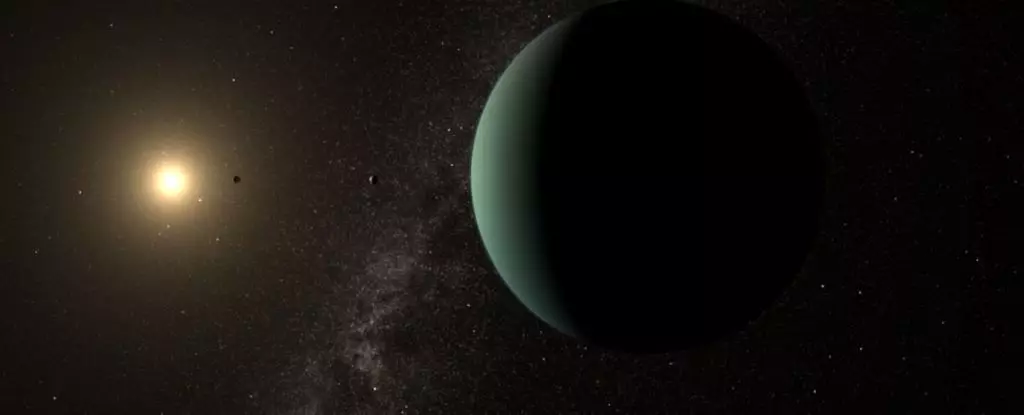Astronomical advancements have led to exciting revelations about our cosmic neighborhood, especially with the discovery of the exoplanet HD 20794 d, which lies a mere 20 light-years away from our Solar System. This finding is groundbreaking as it brings to light the tantalizing possibility of life-sustaining conditions far closer than previously anticipated. The exoplanet, with a mass almost six times that of Earth, orbits a yellow dwarf star, similar to our Sun, in a zone characterized by the potential for liquid water—one of the fundamental ingredients requisite for life as we understand it.
Michael Cretignier, an astrophysicist at Oxford University, expressed his enthusiasm upon confirming the existence of HD 20794 d, acknowledging both the excitement and relief that accompanied the detection of this elusive planet. The confirmation process, fraught with uncertainty given the faintness of initial signals, highlights the complexities and challenges inherent in astrophysical research. It underscores the necessity of robust data analysis techniques and advanced observational tools, such as the European Southern Observatory’s ESPRESSO, which played a pivotal role in securing additional understanding of this intriguing exoplanet.
The concept of a habitable zone is crucial when determining a celestial body’s potential to sustain life. In essence, this zone represents a balanced orbital range around a star where conditions could allow for liquid water to exist. If a planet orbits too close to its star, the intense heat could cause water to vaporize; too far, and water would freeze solid. The positioning of HD 20794 d within this habitable zone is promising, but its elliptical orbit adds an interesting complexity.
The orbit of HD 20794 d lasts approximately 648 days and takes it through varying distances from its star. Due to the elongated, oval shape of its orbit, only part of the planet’s journey falls within the habitable zone, posing questions about the sustainability of conditions that support the presence of liquid water. As researchers delve deeper into the specifics of HD 20794 d’s orbit, they must also consider how variations in distance from its star may affect temperature fluctuations and ultimately the feasibility of supporting life.
Another area of significant interest is the exact composition of HD 20794 d, which remains uncertain. While current modeling indicates that the exoplanet boasts a mass approximate to 5.82 times that of Earth, the ambiguity surrounding its radius means that scientists cannot currently ascertain its density nor its geological nature definitively. This lack of clarity presents a dichotomy: if it has a smaller radius, there’s the potential of it being a rocky super-Earth; conversely, a larger radius could suggest it is a gas-rich mini-Neptune.
Understanding the interplay between these characteristics is essential for evaluating HD 20794 d’s habitability prospects. The density of an exoplanet can yield insights into its geological processes and potential for possessing resources such as an atmosphere and water. These factors can change dramatically the possibility of sustaining life, indicating that further research is necessary to decode the planet’s secrets.
The Implications of Proximity: Future Exploration
The proximity of HD 20794 d to Earth sparks hopes for future exploratory missions that could further unveil the mysteries held by this potential habitable world. As technology advances, the feasibility of capturing direct images of such exoplanets increases, allowing scientists to garner more information about their atmospheres and possible surfaces. Future observations may include spectroscopic analyses that could detect molecular signatures indicative of life or the presence of essential elements.
This ongoing investigation into HD 20794 d illustrates an increasingly profound understanding of the cosmos. As we expand our knowledge on nearby stars and their planets, the prospect of discovering extraterrestrial life is becoming less a figment of science fiction and more a plausible reality. With each discovery, we edge closer to answering the age-old question: Are we alone in the universe?
HD 20794 d is not merely an astral curiosity; it represents a significant step towards understanding the possibilities of life beyond Earth. The excitement surrounding its discovery is not simply about its distance or mass; it embodies a broader narrative about the search for life and the human endeavor of exploration. Each finding ignites our imagination and underscores the fundamental quest for knowledge in the vastness of space, as we continue to seek signs of life among the stars. Future studies of this exoplanet and others like it will serve as stepping stones toward unlocking the mysteries of our universe and potentially discovering life in our cosmic neighborhood.


Leave a Reply